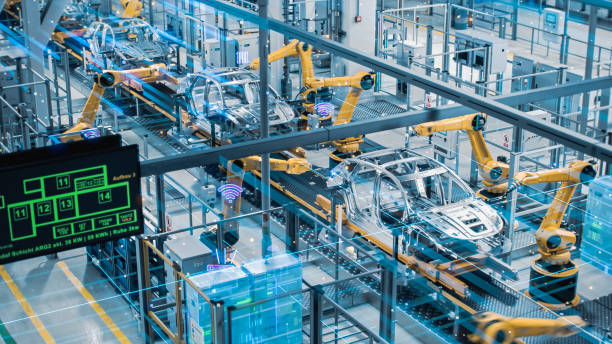Modular Production Systems: Redefining Factory Flexibility
Revolutionizing manufacturing through adaptable production lines and scalable operations, modular production systems are reshaping industrial landscapes. This innovative approach to factory design and management promises enhanced flexibility, reduced downtime, and improved resource utilization. As businesses navigate volatile markets and evolving consumer demands, modular production emerges as a strategic solution for agile manufacturing.

The Evolution of Factory Design
Traditional factory layouts have long been characterized by fixed, linear production lines optimized for high-volume output of specific products. While efficient for mass production, these rigid systems struggle to adapt to market fluctuations and product diversification. The concept of modular production emerged as a response to these limitations, drawing inspiration from modular architecture and the success of flexible manufacturing systems in the automotive industry.
Early experiments with modular production in the 1990s focused primarily on creating easily reconfigurable workstations. However, technological advancements in automation, robotics, and data analytics have since expanded the scope and capabilities of modular systems. Today’s modular production facilities integrate smart sensors, artificial intelligence, and advanced materials handling systems to create truly adaptive manufacturing environments.
Key Components of Modular Production Systems
At the heart of modular production systems are standardized, self-contained production units or “modules.” These modules are designed to perform specific manufacturing tasks and can be easily connected, disconnected, or rearranged to form different production configurations. Key components include:
-
Standardized Interfaces: Universal connection points ensure seamless integration between modules, regardless of manufacturer or function.
-
Plug-and-Play Technology: Advanced control systems allow for rapid module integration and reconfiguration with minimal downtime.
-
Scalable Infrastructure: Modular power, data, and utility systems support easy expansion or contraction of production capacity.
-
Mobile Equipment: Lightweight, wheeled machinery facilitates quick rearrangement of factory layouts.
-
Adaptable Material Handling: Flexible conveyor systems and autonomous guided vehicles (AGVs) enable efficient material flow across changing production configurations.
Benefits and Competitive Advantages
The implementation of modular production systems offers numerous benefits to manufacturers:
-
Increased Flexibility: Rapidly adapt production lines to accommodate new products or changes in demand, reducing time-to-market and improving responsiveness to market trends.
-
Enhanced Efficiency: Optimize resource utilization by easily scaling production capacity up or down based on real-time needs.
-
Reduced Downtime: Quickly isolate and replace faulty modules without disrupting entire production lines, minimizing maintenance-related downtime.
-
Improved Product Customization: Easily reconfigure production lines to handle small batch sizes or personalized products without sacrificing efficiency.
-
Cost Savings: Lower initial capital investment by starting with essential modules and expanding as needed, rather than building a full-scale traditional factory from the outset.
-
Future-Proofing: Modular systems can more easily integrate new technologies and adapt to changing industry standards, extending the lifespan of manufacturing facilities.
Challenges and Considerations
While the potential of modular production systems is significant, several challenges must be addressed for successful implementation:
-
Initial Investment: Although modular systems offer long-term cost savings, the upfront investment in modular equipment and infrastructure can be substantial.
-
Standardization: The lack of universal standards for modular interfaces and control systems can limit interoperability between modules from different manufacturers.
-
Workforce Skills: Operating and maintaining modular production systems requires a highly skilled workforce familiar with advanced technologies and flexible manufacturing principles.
-
Complexity Management: As production systems become more modular and flexible, managing the increased complexity of operations and supply chains becomes crucial.
-
Quality Control: Ensuring consistent product quality across frequently reconfigured production lines presents new challenges for quality assurance processes.
Industry Applications and Case Studies
Modular production systems have found success across various industries:
-
Automotive: Major car manufacturers have implemented modular assembly lines to produce multiple vehicle models on the same production line, significantly reducing retooling time and costs.
-
Electronics: Consumer electronics companies use modular production to quickly adapt to rapid product cycles and seasonal demand fluctuations.
-
Pharmaceuticals: Modular cleanroom environments enable pharmaceutical companies to quickly scale up production of new drugs or adjust to changing regulatory requirements.
-
Food and Beverage: Modular processing and packaging lines allow food manufacturers to easily switch between product variations and packaging formats.
-
Aerospace: Aircraft manufacturers utilize modular assembly stations to handle the complexity of low-volume, high-variability production typical in the aerospace industry.
Implementing Modular Production: Key Strategies
-
Conduct a thorough assessment of current production processes to identify areas suitable for modularization.
-
Start with pilot projects in non-critical areas to gain experience and demonstrate value before full-scale implementation.
-
Invest in comprehensive training programs to ensure workforce readiness for modular operations.
-
Collaborate with equipment suppliers to develop standardized interfaces and control systems.
-
Implement advanced data analytics and simulation tools to optimize module configurations and production flow.
-
Regularly review and update modular strategies to align with evolving business needs and technological advancements.
As industries continue to face unprecedented challenges and opportunities, modular production systems offer a powerful tool for achieving operational agility and competitive advantage. By embracing this innovative approach to manufacturing, businesses can position themselves to thrive in an increasingly dynamic and uncertain market environment. The journey towards fully modular production may be complex, but the potential rewards in terms of flexibility, efficiency, and innovation make it a compelling strategy for forward-thinking manufacturers.





